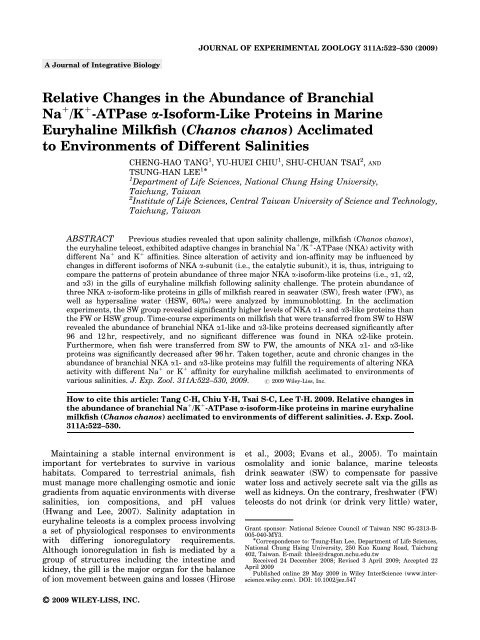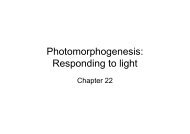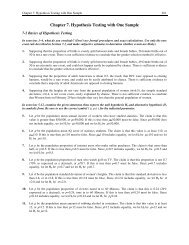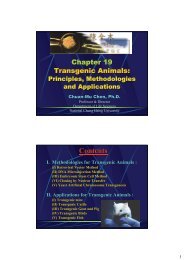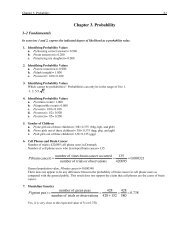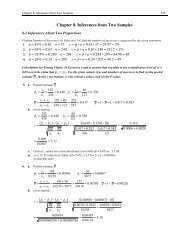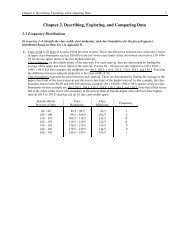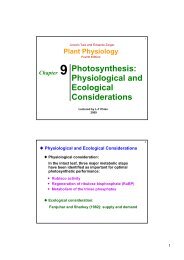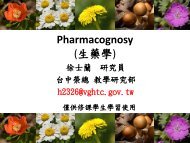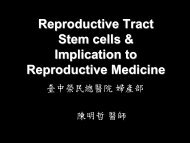isoform-like proteins in marine euryhaline milkfish (Chanos
isoform-like proteins in marine euryhaline milkfish (Chanos
isoform-like proteins in marine euryhaline milkfish (Chanos
Create successful ePaper yourself
Turn your PDF publications into a flip-book with our unique Google optimized e-Paper software.
JOURNAL OF EXPERIMENTAL ZOOLOGY 311A:522–530 (2009)A Journal of Integrative BiologyRelative Changes <strong>in</strong> the Abundance of BranchialNa 1 /K 1 -ATPase a-Isoform-Like Prote<strong>in</strong>s <strong>in</strong> Mar<strong>in</strong>eEuryhal<strong>in</strong>e Milkfish (<strong>Chanos</strong> chanos) Acclimatedto Environments of Different Sal<strong>in</strong>itiesCHENG-HAO TANG 1 , YU-HUEI CHIU 1 , SHU-CHUAN TSAI 2 , ANDTSUNG-HAN LEE 11 Department of Life Sciences, National Chung Hs<strong>in</strong>g University,Taichung, Taiwan2 Institute of Life Sciences, Central Taiwan University of Science and Technology,Taichung, TaiwanABSTRACT Previous studies revealed that upon sal<strong>in</strong>ity challenge, <strong>milkfish</strong> (<strong>Chanos</strong> chanos),the euryhal<strong>in</strong>e teleost, exhibited adaptive changes <strong>in</strong> branchial Na 1 /K 1 -ATPase (NKA) activity withdifferent Na 1 and K 1 aff<strong>in</strong>ities. S<strong>in</strong>ce alteration of activity and ion-aff<strong>in</strong>ity may be <strong>in</strong>fluenced bychanges <strong>in</strong> different <strong>isoform</strong>s of NKA a-subunit (i.e., the catalytic subunit), it is, thus, <strong>in</strong>trigu<strong>in</strong>g tocompare the patterns of prote<strong>in</strong> abundance of three major NKA a-<strong>isoform</strong>-<strong>like</strong> <strong>prote<strong>in</strong>s</strong> (i.e., a1, a2,and a3) <strong>in</strong> the gills of euryhal<strong>in</strong>e <strong>milkfish</strong> follow<strong>in</strong>g sal<strong>in</strong>ity challenge. The prote<strong>in</strong> abundance ofthree NKA a-<strong>isoform</strong>-<strong>like</strong> <strong>prote<strong>in</strong>s</strong> <strong>in</strong> gills of <strong>milkfish</strong> reared <strong>in</strong> seawater (SW), fresh water (FW), aswell as hypersal<strong>in</strong>e water (HSW, 60%) were analyzed by immunoblott<strong>in</strong>g. In the acclimationexperiments, the SW group revealed significantly higher levels of NKA a1- and a3-<strong>like</strong> <strong>prote<strong>in</strong>s</strong> thanthe FW or HSW group. Time-course experiments on <strong>milkfish</strong> that were transferred from SW to HSWrevealed the abundance of branchial NKA a1-<strong>like</strong> and a3-<strong>like</strong> <strong>prote<strong>in</strong>s</strong> decreased significantly after96 and 12 hr, respectively, and no significant difference was found <strong>in</strong> NKA a2-<strong>like</strong> prote<strong>in</strong>.Furthermore, when fish were transferred from SW to FW, the amounts of NKA a1- and a3-<strong>like</strong><strong>prote<strong>in</strong>s</strong> was significantly decreased after 96 hr. Taken together, acute and chronic changes <strong>in</strong> theabundance of branchial NKA a1- and a3-<strong>like</strong> <strong>prote<strong>in</strong>s</strong> may fulfill the requirements of alter<strong>in</strong>g NKAactivity with different Na 1 or K 1 aff<strong>in</strong>ity for euryhal<strong>in</strong>e <strong>milkfish</strong> acclimated to environments ofvarious sal<strong>in</strong>ities. J. Exp. Zool. 311A:522–530, 2009. r 2009 Wiley-Liss, Inc.How to cite this article: Tang C-H, Chiu Y-H, Tsai S-C, Lee T-H. 2009. Relative changes <strong>in</strong>the abundance of branchial Na 1 /K 1 -ATPase a-<strong>isoform</strong>-<strong>like</strong> <strong>prote<strong>in</strong>s</strong> <strong>in</strong> mar<strong>in</strong>e euryhal<strong>in</strong>e<strong>milkfish</strong> (<strong>Chanos</strong> chanos) acclimated to environments of different sal<strong>in</strong>ities. J. Exp. Zool.311A:522–530.Ma<strong>in</strong>ta<strong>in</strong><strong>in</strong>g a stable <strong>in</strong>ternal environment isimportant for vertebrates to survive <strong>in</strong> varioushabitats. Compared to terrestrial animals, fishmust manage more challeng<strong>in</strong>g osmotic and ionicgradients from aquatic environments with diversesal<strong>in</strong>ities, ion compositions, and pH values(Hwang and Lee, 2007). Sal<strong>in</strong>ity adaptation <strong>in</strong>euryhal<strong>in</strong>e teleosts is a complex process <strong>in</strong>volv<strong>in</strong>ga set of physiological responses to environmentswith differ<strong>in</strong>g ionoregulatory requirements.Although ionoregulation <strong>in</strong> fish is mediated by agroup of structures <strong>in</strong>clud<strong>in</strong>g the <strong>in</strong>test<strong>in</strong>e andkidney, the gill is the major organ for the balanceof ion movement between ga<strong>in</strong>s and losses (Hiroseet al., 2003; Evans et al., 2005). To ma<strong>in</strong>ta<strong>in</strong>osmolality and ionic balance, mar<strong>in</strong>e teleostsdr<strong>in</strong>k seawater (SW) to compensate for passivewater loss and actively secrete salt via the gills aswell as kidneys. On the contrary, freshwater (FW)teleosts do not dr<strong>in</strong>k (or dr<strong>in</strong>k very little) water,Grant sponsor: National Science Council of Taiwan NSC 95-2313-B-005-040-MY3. Correspondence to: Tsung-Han Lee, Department of Life Sciences,National Chung Hs<strong>in</strong>g University, 250 Kuo Kuang Road, Taichung402, Taiwan. E-mail: thlee@dragon.nchu.edu.twReceived 24 December 2008; Revised 3 April 2009; Accepted 22April 2009Published onl<strong>in</strong>e 29 May 2009 <strong>in</strong> Wiley InterScience (www.<strong>in</strong>terscience.wiley.com).DOI: 10.1002/jez.547r 2009 WILEY-LISS, INC.
RELATIVE CHANGES IN THE ABUNDANCE OF BRANCHIAL 523produce diluted ur<strong>in</strong>e via the kidneys to balancethe passive water ga<strong>in</strong>, and actively absorb saltsthrough the gills from the environment (Marshalland Grosell, 2006). Effective ionoregulatory mechanismsthus enable teleosts to reta<strong>in</strong> an osmoticand ionic constancy <strong>in</strong> their <strong>in</strong>ternal milieus andsurvive <strong>in</strong> hypertonic or hypotonic environments.Na 1 /K 1 -ATPase (NKA) is a membrane-spann<strong>in</strong>gprote<strong>in</strong> that couples the exchange of twoextracellular K 1 ions for three <strong>in</strong>tracellular Na 1ions to the hydrolysis of one molecule of ATP (Postand Jolly, ’57). It is crucial not only for susta<strong>in</strong><strong>in</strong>g<strong>in</strong>tracellular homeostasis, but also for provid<strong>in</strong>g adriv<strong>in</strong>g force for many transport<strong>in</strong>g systems<strong>in</strong>clud<strong>in</strong>g fish gills (Hwang and Lee, 2007). Thea-subunit of NKA conta<strong>in</strong><strong>in</strong>g the b<strong>in</strong>d<strong>in</strong>g sites forATP, Na 1 , and K 1 is considered to be the catalyticsubunit. The b-subunit is a type II glycosylatedpolypeptide that is thought to assist <strong>in</strong> the fold<strong>in</strong>gand placement of the a-subunit <strong>in</strong>to the cellmembrane (Blanco and Mercer, ’98). A third,nonessential g-subunit has been identified <strong>in</strong>mammals (Reeves et al., ’80) and is thought toplay roles <strong>in</strong> modulat<strong>in</strong>g Na 1 , K 1 , and ATPb<strong>in</strong>d<strong>in</strong>g aff<strong>in</strong>ities to the NKA ab complex (Therienet al., ’99). Immunocytochemical studies demonstratedthat NKA was localized ma<strong>in</strong>ly <strong>in</strong> epithelialmitochondrion-rich cells of teleostean gills.The current model depicted that mitochondrionrichcells <strong>in</strong> gill epithelia of teleosts used NKA asthe primary driv<strong>in</strong>g force for operation of thedifferent ion transporters depend<strong>in</strong>g on theenvironmental sal<strong>in</strong>ity (Hwang and Lee, 2007;Evans, 2008).NKA exhibits four a (a1-4) and three b (b1-3)<strong>isoform</strong>s. Sequence variations <strong>in</strong> the am<strong>in</strong>o term<strong>in</strong>usand 11 am<strong>in</strong>o acids <strong>in</strong> the large <strong>in</strong>tracellularloop between transmembrane doma<strong>in</strong>s 4 and 5dist<strong>in</strong>guished four <strong>isoform</strong>s of the NKA a-subunit(Takeyasu et al., ’90; Pressley, ’92). Thesea-subunit <strong>isoform</strong>s, which showed tissue-specificand developmentally dependent patterns of expression<strong>in</strong> birds and mammals, have beensuggested to be presented <strong>in</strong> all vertebrate classes,<strong>in</strong>clud<strong>in</strong>g teleosts (Takeyasu et al., ’90; Pressley,’92). Compar<strong>in</strong>g the sequences of one orthologous<strong>isoform</strong> from many different species yields anam<strong>in</strong>o acid identity of 90% or greater (Blanco andMercer, ’98). In teleosts, full length sequence ofNKA a-<strong>isoform</strong>s have been cloned <strong>in</strong> the whitesucker (a1; Catostomus commersoni; Schönrocket al., ’91), the European eel (a; Anguilla anguilla;Cutler et al., ’95), tilapia (a1 and a3; Oreochromismossambicus; Feng et al., 2002), killifish (a1 anda2; Fundulus heteroclitus; Semple et al., 2002),and ra<strong>in</strong>bow trout (a1a, a1b, a1c, a2, and a3;Oncorhynchus mykiss; Richards et al., 2003). Inaddition, n<strong>in</strong>e dist<strong>in</strong>ct NKA a-subunit genes havebeen identified <strong>in</strong> zebrafish (Danio rerio) genomicdatabases. Among them, four (a1a.1, a1a.2, a1a.4,and a1a.5) of the seven a1 genes were found to beexpressed <strong>in</strong> the mucous cells of sk<strong>in</strong> (Blasioleet al., 2002; Canfield et al., 2002). In addition,partial sequences of a-<strong>isoform</strong>s were reported <strong>in</strong>the sp<strong>in</strong>y dogfish (a3; Squalus acanthias; Hansen,’99) and the Antarctic nototheniid (a1, a2, and a3;Trematomus bernachii; Guynn et al., 2002).Milkfish (<strong>Chanos</strong> chanos) is a mar<strong>in</strong>e teleostwidely distributed throughout the tropical andsubtropical Indo-Pacific. The euryhal<strong>in</strong>ity of <strong>milkfish</strong>was demonstrated throughout its life history,although it did not appear to require the freshwater (FW) for any part of its life cycle (Bagr<strong>in</strong>ao,’94). Milkfish are found naturally or culturedcommercially <strong>in</strong> FW, SW, and hypersal<strong>in</strong>e water(HSW) (Crear, ’80). These characteristics make<strong>milkfish</strong> a good experimental species for studies onosmoregulation. Previous studies revealed that<strong>milkfish</strong>, <strong>like</strong> other euryhal<strong>in</strong>e teleosts, exhibitedadaptive changes <strong>in</strong> branchial NKA responses (i.e.,mRNA, prote<strong>in</strong>, activity, immunoreactive cellnumber) upon sal<strong>in</strong>ity challenge (L<strong>in</strong> et al., 2003,2006). Moreover, Pagliarani et al. (’91) demonstratedthat NKA <strong>prote<strong>in</strong>s</strong> isolated from FW- andSW-acclimated fish gills had different biochemicalproperties and suggested that different NKA<strong>isoform</strong>s might correlate with ion regulation <strong>in</strong>different environmental sal<strong>in</strong>ities. S<strong>in</strong>ce a-subunitis the catalytic subunit of NKA, alteration of NKAa-<strong>isoform</strong>s prote<strong>in</strong> expression was supposed to be acrucial mechanism for euryhal<strong>in</strong>e teleosts to adaptto environments of various sal<strong>in</strong>ities. Feng et al.(2002) provided evidence of enhanced transcriptionof branchial NKA a1 and a3 genes <strong>in</strong>Mozambique tilapia follow<strong>in</strong>g transfer from FWto SW. Recent studies focused on mRNA expressionpatterns of two NKA a-<strong>isoform</strong>s (a1a and a1b)revealed their different responses to sal<strong>in</strong>itychanges <strong>in</strong> salmonid fishes (Richards et al., 2003;Shrimpton et al., 2005; Bystriansky et al., 2006,2007a,b; Nilsen et al., 2007). However, Morrisonet al. (2006) reported that changes <strong>in</strong> the prote<strong>in</strong>,but not mRNA levels of NKA a-subunit <strong>isoform</strong>s(i.e., a1, a2, and a3), occurred <strong>in</strong> the gills of warmacclimated Antarctic teleost (Trematomus bernacchii).This motivates this study to <strong>in</strong>vestigate theprote<strong>in</strong> expression patterns of gill NKA a-subunit<strong>isoform</strong>s <strong>in</strong> euryhal<strong>in</strong>e <strong>milkfish</strong> follow<strong>in</strong>g sal<strong>in</strong>ity-J. Exp. Zool.
524C.-H. TANG ET AL.transfer, to illustrate the potential role of NKAa-<strong>isoform</strong>s <strong>in</strong> this mar<strong>in</strong>e euryhal<strong>in</strong>e teleost uponsal<strong>in</strong>ity challenge.MATERIALS AND METHODSExperimental animalsJuvenile <strong>milkfish</strong> (C. chanos) with 13.670.2 cmtotal length and 22.175.9 g body weight wereobta<strong>in</strong>ed from a local fish farm. Values of total lengthand body weight were expressed as the mean7SEM.SW (35%) orHSW(60%) were prepared from localtap water (i.e., FW) added with proper amounts ofsynthetic sea salt (Instant Ocean, Aquarium Systems,Mentor, OH). The water was cont<strong>in</strong>uously circulatedthrough fabric-floss filters. Milkfish were kept <strong>in</strong> SWat 28711C with a daily 12 hr photoperiod for at leasttwo weeks before experiments. Fish were fed a dailydiet of commercial fodder.Acclimation experimentsMilkfish kept <strong>in</strong> the laboratory for at least twoweeks were transferred <strong>in</strong>to experimental tankswith HSW, SW, and FW, respectively, and theculture conditions were identical to thosedescribed above. Milkfish were held <strong>in</strong> experimentaltanks for two weeks prior to sampl<strong>in</strong>g.Time-course environmentsFor time-course experiments, <strong>milkfish</strong> of theexperimental group were transferred directly fromstock SW to FW or HSW, while fish <strong>in</strong> the controlgroup were transferred to SW simultaneously.Because fish were transferred by nets, the controlgroup was used to monitor the effect of handl<strong>in</strong>gfish alone. After transfer, the fish were caught bynett<strong>in</strong>g at 12, 24, 48, 96, and 168 hr and sampledfor immunoblott<strong>in</strong>g.Preparation of gill homogenatesGills were excised and blotted dry. After remov<strong>in</strong>gthe gill arches, gills were immediately cut <strong>in</strong>tosmall pieces. All subsequent procedures wereperformed on ice. Gill scrap<strong>in</strong>gs were suspended<strong>in</strong> the mixture of homogenization solution (100 mMimidazole-HCl buffer, pH 7.6; 5 mM Na 2 EDTA;200 mM sucrose; and 0.1% sodium deoxycholate)and prote<strong>in</strong>ase <strong>in</strong>hibitors (10 mg antipa<strong>in</strong>, 5 mgleupept<strong>in</strong>, and 50 mg benzamid<strong>in</strong>e dissolved <strong>in</strong>5 mL aprot<strong>in</strong><strong>in</strong>) (v/v: 100/1). Homogenization wasperformed with a homogenizer (Polytron PT1200E KINEMATICA, Lucerne, Switzerland) at amaximum speed for 25 strokes. The homogenateswere then centrifuged at 13,000g for 20 m<strong>in</strong> at 41C.The supernatants were used to determ<strong>in</strong>e prote<strong>in</strong>concentrations and for immunoblott<strong>in</strong>g. Prote<strong>in</strong>concentrations were identified by BCA prote<strong>in</strong>assay reagents (PIERCE, Rockford, IL) us<strong>in</strong>gbov<strong>in</strong>e serum album<strong>in</strong> (Sigma, St. Louis, MO) asa standard. All gill lysates were stored at 801Cbefore immunoblott<strong>in</strong>g.AntibodiesNKA a1-<strong>isoform</strong> antibody, mouse monoclonalantibody (a6F) raised aga<strong>in</strong>st the a1-<strong>isoform</strong> of theavian NKA was purchased from the DevelopmentalStudies Hybridoma Bank (DSHB; Iowa City,IA). The dilution rate is 1:5,000 for immunoblott<strong>in</strong>g.NKA a2-<strong>isoform</strong> antibody was the commercialgoat polyclonal antibody (sc-16049), raisedaga<strong>in</strong>st a peptide mapp<strong>in</strong>g with<strong>in</strong> an <strong>in</strong>ternalregion of the NKA a2-subunit of human orig<strong>in</strong>(Santa Cruz Biotechnology, Santa Cruz, CA). Thedilution rate is 1:500 for immunoblott<strong>in</strong>g. NKAa3-<strong>isoform</strong> antibody was the commercial goatpolyclonal antibody (sc-16052), raised aga<strong>in</strong>st apeptide mapp<strong>in</strong>g with<strong>in</strong> an <strong>in</strong>ternal region of NKAa3 of human orig<strong>in</strong> (Santa Cruz Biotechnology).The dilution rate is 1:100 for immunoblott<strong>in</strong>g.Alkal<strong>in</strong>e phosphatase-conjugated goat anti-mouseor rabbit anti-goat antibodies (Jackson ImmunoResearch, West Grove, PA) were used as secondaryantibodies for immunoblott<strong>in</strong>g.Immunoblott<strong>in</strong>g analysisImmunoblott<strong>in</strong>g procedures were performed accord<strong>in</strong>gto Tang et al. (2008) with little modification.Seventy-five microgram of prote<strong>in</strong> from gillhomogenates was heated with sample buffer at371C for 30 m<strong>in</strong> and fractionated by electrophoresison sodium dodecyl sulfate-conta<strong>in</strong><strong>in</strong>g 7.5% polyacrylamidegels. The presta<strong>in</strong>ed prote<strong>in</strong> molecularweight marker was purchased form Fermentas(SM0671; Hanover, MD). Separated <strong>prote<strong>in</strong>s</strong> werethen electro-ransferred to PVDF membranes(Millipore, Bedford, MA). Blots were pre<strong>in</strong>cubated<strong>in</strong> PBST (phosphate buffer sal<strong>in</strong>e with Tween 20)buffer (137 mmol L 1 NaCl; 3 mmol L 1 KCl;10 mmol L 1 Na 2 HPO 4 ;2mmolL 1 KH 2 PO 4 ;0.2%Tween 20; pH 7.4) conta<strong>in</strong><strong>in</strong>g 5% w/v nonfat driedmilk to m<strong>in</strong>imize nonspecific b<strong>in</strong>d<strong>in</strong>g, then <strong>in</strong>cubatedat 41C overnight, with the primary antibodiesdiluted <strong>in</strong> PBST conta<strong>in</strong><strong>in</strong>g 1% BSA and 0.05%sodium azide. The blots were washed <strong>in</strong> PBST and<strong>in</strong>cubated at room temperature for 1 hr withJ. Exp. Zool.
RELATIVE CHANGES IN THE ABUNDANCE OF BRANCHIAL 525secondary antibodies. Blots were developed after<strong>in</strong>cubation with BCIP/NBT kit (Zymed, South SanFrancisco, CA). Immunoblots were scanned andimages were imported as TIF files <strong>in</strong>to thecommercial image analysis software package(MCID software; Imag<strong>in</strong>g Research, Ontario,Canada). Results were converted to numericalvalues <strong>in</strong> order to compare the relative <strong>in</strong>tensitiesof the immunoreactive bands.Statistical analysisValues of relative <strong>in</strong>tensities of immunoreactivebands were expressed as the mean7SEM andcompared us<strong>in</strong>g the one-way analysis of variance(ANOVA) followed by Tukey’s pair-wise methodfor acclimation experiments or Dunnett’s test fortime-course experiments.RESULTSLong-term acclimation of <strong>milkfish</strong> toenvironments with different sal<strong>in</strong>itiesThe antibodies correspond<strong>in</strong>g to different NKAa-<strong>isoform</strong>s (a1, a2, and a3) were used to determ<strong>in</strong>ethe prote<strong>in</strong> expression patterns <strong>in</strong> <strong>milkfish</strong> gills.An approximately 105 kDa NKA a1-<strong>like</strong> immunoreactiveprote<strong>in</strong> was detected <strong>in</strong> gill homogenatespreparations from <strong>milkfish</strong> acclimated todifferent sal<strong>in</strong>ities (Fig. 1A). The <strong>in</strong>tensity ofimmunoreactive bands <strong>in</strong> the SW-acclimatedgroup was about 4-fold higher than the FWacclimatedfish or HSW-acclimated fish (Fig. 1B).Immunoblots of NKA a2-<strong>like</strong> prote<strong>in</strong> resulted <strong>in</strong> as<strong>in</strong>gle immunoreactive band of about 114 kDa(Fig. 2A). The immunoreactive bands were similaramong all groups. Relative prote<strong>in</strong> abundance <strong>in</strong>the immunoreactive bands revealed the prote<strong>in</strong>abundance of NKA a2-<strong>like</strong> prote<strong>in</strong> <strong>in</strong> the gills wereunaffected by environmental sal<strong>in</strong>ity (Fig. 2B).Immunoblots of NKA a3-<strong>like</strong> prote<strong>in</strong> also resulted<strong>in</strong> a s<strong>in</strong>gle immunoreactive band of about 105 kDa(Fig. 3A). Similar to the pattern of a1-<strong>like</strong> prote<strong>in</strong>,<strong>milkfish</strong> exposed to SW environment exhibiteda significant <strong>in</strong>crease (about 1.5-folds) <strong>in</strong> NKAa3-<strong>like</strong> prote<strong>in</strong> expression compared with <strong>in</strong>dividualsexposed to FW and HSW (Fig. 3B).Abrupt exposure of <strong>milkfish</strong> from SW toHSWLike the experiment of long-term acclimation, a105 kDa NKA a1-<strong>like</strong> immunoreactive prote<strong>in</strong> wasdetected <strong>in</strong> the gill of <strong>milkfish</strong> (Fig. 4A). Comparedto the 0 hr group, the levels of NKA a1-<strong>like</strong> prote<strong>in</strong>Fig. 1. The prote<strong>in</strong> expression of Na 1 /K 1 -ATPase a1-<strong>like</strong>prote<strong>in</strong> <strong>in</strong> the gills of <strong>milkfish</strong> acclimated to environments ofdifferent sal<strong>in</strong>ities for two weeks. (A) Representative immunoblotprobed with a monoclonal antibody. The <strong>in</strong>dicatedimmunoreactive band is approximately at 105 kDa (arrow).The immunoreactive bands of SW-acclimated fish were more<strong>in</strong>tensive than FW- or HSW-acclimated <strong>in</strong>dividuals. (B) Therelative prote<strong>in</strong> abundance of immunoreactive bands of theSW group was 4-fold higher than those of FW or HSW groups.Values were mean7SEM (n 5 6). The asterisk <strong>in</strong>dicated asignificant difference (Po0.05) us<strong>in</strong>g Tukey’s pair-wisecomparison test follow<strong>in</strong>g a one-way ANOVA. M, marker;FW, fresh water; SW, seawater; HSW, hypersal<strong>in</strong>e water.<strong>in</strong> gills decl<strong>in</strong>ed gradually with<strong>in</strong> 48 hr posttransferand were decreased 4-fold at 96 hrand susta<strong>in</strong>ed to 168 hr after sal<strong>in</strong>ity transfer (Fig.4B). The representative immunoblot of NKA a2-<strong>like</strong>prote<strong>in</strong> resulted <strong>in</strong> a s<strong>in</strong>gle immunoreactive band ofabout 114 kDa (Fig. 5A). Compared to the 0 hrgroup, the abundance of branchial NKAa2-<strong>like</strong> prote<strong>in</strong> was not significantly differentfollow<strong>in</strong>g sal<strong>in</strong>ity transfer (Fig. 5B). Moreover,NKA a3-<strong>like</strong> immunoreactive <strong>prote<strong>in</strong>s</strong> were detected<strong>in</strong> gill prote<strong>in</strong> preparations from <strong>milkfish</strong>.The NKA a3-<strong>like</strong> prote<strong>in</strong> was approximately105kDa (Fig. 6A). Compared to the 0hr group,prote<strong>in</strong> levels of gill NKA a3-<strong>like</strong> prote<strong>in</strong> decreasedsignificantly s<strong>in</strong>ce 12 hr post-transfer (Fig. 6B). Nosignificant difference was found <strong>in</strong> the levels of threeNKA a-<strong>isoform</strong>-<strong>like</strong> <strong>prote<strong>in</strong>s</strong> dur<strong>in</strong>g the time-course<strong>in</strong> the control group fish (Figs. 4B, 5B, and 6B).J. Exp. Zool.
RELATIVE CHANGES IN THE ABUNDANCE OF BRANCHIAL 527Fig. 4. The summary of Na 1 /K 1 -ATPase (NKA) a1-<strong>like</strong>prote<strong>in</strong> <strong>in</strong> the gills of <strong>milkfish</strong> sampled at a series of differenttimes after transfer from SW to HSW or FW. (A) Representativeimmunoblots of NKA a1-<strong>like</strong> prote<strong>in</strong> probed with amonoclonal antibody revealed s<strong>in</strong>gle immunoreactive bands atapproximately 105 kDa. (B) The relative prote<strong>in</strong> abundancefollow<strong>in</strong>g transfer from SW to HSW <strong>in</strong>dicated that NKAa1-<strong>like</strong> prote<strong>in</strong> levels decl<strong>in</strong>ed gradually dur<strong>in</strong>g the first 48 hrpost-transfer and decreased 4-fold at 96 and 168 hr aftertransfer. When fish were transferred from SW to FW, NKAa1-<strong>like</strong> prote<strong>in</strong> levels decreased dur<strong>in</strong>g the first 12 hr posttransfer,then <strong>in</strong>creased gradually until 48 hr post-transfer,and f<strong>in</strong>ally decreased 3-fold at 96 and 168 hr post-transfer.Values were mean7SEM (n 5 6). The asterisks <strong>in</strong>dicatedsignificant differences (Po0.05) compared with the 0 hr us<strong>in</strong>gDunnett’s test follow<strong>in</strong>g a one-way ANOVA. M, marker; SW,seawater; HSW, hypersal<strong>in</strong>e water.<strong>in</strong> both absorptive (<strong>in</strong> FW) and secretory (<strong>in</strong> SW)modes (Marshall, 2002; Hwang and Lee, 2007).The branchial NKA expression (mRNA, prote<strong>in</strong>,and activity) were higher <strong>in</strong> <strong>milkfish</strong> acclimated toFW (L<strong>in</strong> et al., 2003, 2006) and HSW (unpublisheddata) than SW-acclimated <strong>in</strong>dividuals. This <strong>in</strong>dicatesthat this mar<strong>in</strong>e species ma<strong>in</strong>ta<strong>in</strong>s a comparativelylow level of NKA expression <strong>in</strong> theirprimary natural habitats. Similarly, some euryhal<strong>in</strong>eteleosts responded to FW with higher gillNKA expression, e.g., European seabass (Dicentrarchuslabrax; Lasserre, ’71), mullets (Mugilcephalus; Ciccotti et al., ’94), gilthead Sea Bream(Sparus auratusand; Laiz-Carrión et al., 2005),black porgy (Acanthopagrus schlegeli; Choi andAn, 2008). On the contrary, the other euryhal<strong>in</strong>eteleosts responded with higher gill NKA expressionfollow<strong>in</strong>g acclimation to SW, e.g., Atlanticsalmon (Salmo salar; D’Cotta et al., 2000), tilapiaFig. 5. The summary of Na 1 /K 1 -ATPase (NKA) a2-<strong>like</strong>prote<strong>in</strong> <strong>in</strong> gills of <strong>milkfish</strong> sampled at a series of differenttimes after transfer from SW to HSW or FW. (A) Representativeimmunoblots of NKA a2-<strong>like</strong> prote<strong>in</strong> probed with apolyclonal antibody revealed s<strong>in</strong>gle immunoreactive bands atapproximately 114 kDa. (B) The relative prote<strong>in</strong> abundancefollow<strong>in</strong>g transfer from SW to HSW or FW <strong>in</strong>dicated that NKAa2-<strong>like</strong> prote<strong>in</strong> expression was not significantly differentfollow<strong>in</strong>g sal<strong>in</strong>ity transfer compared to the 0 hr. Values weremean7SEM (n 5 6). The asterisks <strong>in</strong>dicated significantdifferences (Po0.05) compared with the 0 hr us<strong>in</strong>g Dunnett’stest follow<strong>in</strong>g a one-way ANOVA. M, marker; SW, seawater;HSW, hypersal<strong>in</strong>e water.(Oreochromis mossambicus; Lee et al., 2003), andspotted green pufferfish (Teteaodon nigroviridis;L<strong>in</strong> et al., 2004). Different patterns of sal<strong>in</strong>itydependentbranchial NKA expression may resultfrom diverse primary natural habitats of euryhal<strong>in</strong>eteleosts with differ<strong>in</strong>g mechanisms to respondto ambient sal<strong>in</strong>ity changes. Furthermore, branchialNKA <strong>prote<strong>in</strong>s</strong> isolated from FW- and SWacclimatedra<strong>in</strong>bow trout (Oncorhynchus mykiss)exhibited different biochemical properties. It wassuggested that diverse NKA <strong>isoform</strong>s might be<strong>in</strong>volved <strong>in</strong> ionoregulation of environments withdifferent sal<strong>in</strong>ities (Pagliarani et al., ’91).Characterization of rat NKA a- and b-<strong>isoform</strong>s<strong>in</strong> <strong>in</strong>sect cell l<strong>in</strong>es demonstrated that Na 1 and K 1aff<strong>in</strong>ity varied among NKA <strong>isoform</strong> comb<strong>in</strong>ationswith a rank order of a2b14a1b14a3b1 anda1b14a2b14a3b1, respectively (Blanco andMercer, ’98). The biochemical or k<strong>in</strong>etic propertiesof NKA were thus strongly <strong>in</strong>fluenced by different<strong>isoform</strong>s of catalytic a-subunit to match physiologicaldemands. Different aff<strong>in</strong>ities of gill NKAfor Na 1 and K 1 were reported <strong>in</strong> FW- andJ. Exp. Zool.
528C.-H. TANG ET AL.Fig. 6. The summary of Na 1 /K 1 -ATPase (NKA) a3-<strong>isoform</strong><strong>in</strong> gills of <strong>milkfish</strong> sampled at a series of different timesafter transfer from SW to HSW or FW. (A) Representativeimmunoblots of NKA a3-<strong>isoform</strong> probed with a polyclonalantibody revealed s<strong>in</strong>gle immunoreactive bands at approximately105 kDa. (B) The relative prote<strong>in</strong> abundance follow<strong>in</strong>gtransfer from SW to HSW <strong>in</strong>dicated that NKA a3-<strong>isoform</strong>decreased significantly after 12 hr post-transfer. On the otherhand, follow<strong>in</strong>g transfer from SW to FW, changes <strong>in</strong> therelative prote<strong>in</strong> abundance of NKA a3-<strong>isoform</strong> levels decl<strong>in</strong>edgradually dur<strong>in</strong>g 48 hr post-transfer and significantly decreasedat 96 and 168 hr post-transfer. Values were mean7SEM (n 5 6). The asterisks <strong>in</strong>dicated significant differences(Po0.05) compared with the 0 hr us<strong>in</strong>g Dunnett’s testfollow<strong>in</strong>g a one-way ANOVA. M, marker; SW, seawater;HSW, hypersal<strong>in</strong>e water.SW-acclimated <strong>milkfish</strong> (L<strong>in</strong> and Lee, 2005).Therefore, alteration of NKA activity <strong>in</strong> gills offish follow<strong>in</strong>g sal<strong>in</strong>ity changes may result fromdifferent NKA <strong>isoform</strong>s.There is accumulat<strong>in</strong>g evidence to presume thatNKA a-<strong>isoform</strong>s may change <strong>in</strong> teleosts to copewith the environmental fluctuations, e.g., sal<strong>in</strong>ityor temperature. The mRNA expression patterns ofgill NKA a1a and a1b exam<strong>in</strong>ed <strong>in</strong> varioussalmonid species were found to express differentially<strong>in</strong> FW- and SW-acclimated <strong>in</strong>dividuals(Richards et al., 2003; Bystriansky et al., 2006,2007a,b; Nilsen et al., 2007). Changes <strong>in</strong> mRNAexpression are often assumed to parallel changes <strong>in</strong>prote<strong>in</strong> abundance. The lack of correlationbetween mRNA and prote<strong>in</strong> of branchial NKAa-<strong>isoform</strong>s was reported (Morrison et al., 2006). Thislack of correlation between mRNA and <strong>prote<strong>in</strong>s</strong>uggested the correlation with posttranscriptionalregulation (Scott et al., 2004). This study,therefore, <strong>in</strong>vestigates the effect of environmentalsal<strong>in</strong>ity on the prote<strong>in</strong> expression of branchialNKA a-<strong>isoform</strong>s-<strong>like</strong> <strong>prote<strong>in</strong>s</strong> <strong>in</strong> <strong>milkfish</strong>.The am<strong>in</strong>o acid identities of <strong>in</strong>dividual <strong>isoform</strong>sacross species are higher than the identities ofdifferent <strong>isoform</strong>s with<strong>in</strong> one species (Blanco andMercer, 1998). Therefore, the heterologous antibodiesto NKA a-<strong>isoform</strong>s (polyclonal antibodiesdirected aga<strong>in</strong>st the rat a-specific <strong>isoform</strong>s) wereused <strong>in</strong> Atlantic salmon (Salmo salar) (D’Cottaet al., 2000) as well as <strong>in</strong> this study. Among the<strong>isoform</strong>-specific heterologous antibodies used <strong>in</strong><strong>milkfish</strong>, mouse monoclonal antibody a6F to theavian NKA a1-<strong>isoform</strong> and goat polyclonal antibodysc-16052 to human NKA a3-<strong>isoform</strong> had beenapplied <strong>in</strong> teleosts previously (tilapia, Oreochromismossambicus; Lee et al., 1998; Antarctic fish,Trematomus bernacchii; Brauer et al., 2005). Thisstudy identified three NKA a-<strong>isoform</strong>-<strong>like</strong> <strong>prote<strong>in</strong>s</strong><strong>in</strong> <strong>milkfish</strong> gills with these <strong>isoform</strong>-specific antibodiesby immunoblott<strong>in</strong>g analysis (Figs. 1A, 2A,and 3A). Three NKA a-<strong>isoform</strong>-<strong>like</strong> <strong>prote<strong>in</strong>s</strong> werealso found <strong>in</strong> the gills of Antarctic fish (Guynnet al., 2002), while only a1 anda3 werereported<strong>in</strong>tilapia gills (Lee et al., 1998; Feng et al., 2002). Theimmunoblots of <strong>milkfish</strong> gill lysates probed witheach <strong>isoform</strong>-specific antibody revealed s<strong>in</strong>gle immunoreactivebands at approximately 105–115 kDa(Figs. 1A, 2A, and 3A), similar to those recognized<strong>in</strong> tilapia (Lee et al., 1998) and Antarctic fish(Guynn et al., 2002; Brauer et al., 2005).This study revealed that the SW-acclimatedgroup was significantly higher than the FW- orHSW-acclimated groups <strong>in</strong> the levels of NKAa1- and a3-<strong>like</strong> <strong>prote<strong>in</strong>s</strong> (Figs. 1 and 3). Expressionpattern of NKA a2-<strong>like</strong> prote<strong>in</strong> <strong>in</strong> the gills were notsal<strong>in</strong>ity-dependent (Fig. 2B). It was suggested thata1- and a3-<strong>like</strong> <strong>prote<strong>in</strong>s</strong> might play the role forosmo- or ionoregulation but a2-<strong>like</strong> prote<strong>in</strong> probablyperformed the other physiological function.The aff<strong>in</strong>ity of gill NKA for sodium <strong>in</strong>creasedsignificantly <strong>in</strong> warm-acclimated Antarctic teleost(T. bernacchii; Morrison et al., 2006) that isopposite to <strong>milkfish</strong>, which has lower sodiumaff<strong>in</strong>ity <strong>in</strong> SW than FW (L<strong>in</strong> and Lee, 2005).Upregulation of gill a1- and a2-<strong>like</strong> <strong>prote<strong>in</strong>s</strong><strong>in</strong>fluenced sodium aff<strong>in</strong>ities and fulfilled some ofthe requirements for the subtly moderated enzymebehaviors (e.g., elevated NKA activity) <strong>in</strong> warmacclimatedT. bernacchii (Morrison et al., 2006),while the changes <strong>in</strong> gill NKA a1- and a3-<strong>like</strong><strong>prote<strong>in</strong>s</strong> may play the potential role for reductionof sodium aff<strong>in</strong>ities to decrease NKA activity <strong>in</strong>SW-exposed <strong>milkfish</strong>. In addition, the role of NKAJ. Exp. Zool.
KRITJA IN ZAVAROVANJANasprotne stranke imajo vzpostavljene postopke obvladovanja tveganja, za katere je potrebnapravočasna, natančna <strong>in</strong> ustrezno ločena izmenjava zavarovanja v zvezi s pogodbami oizvedenih f<strong>in</strong>ančnih <strong>in</strong>strumentih OTC, ki se sklenejo 16. avgusta 2012 ali pozneje (velja zaFNS) oziroma na datum prekoračitve praga klir<strong>in</strong>ga ali po njem (velja za NNS+).FNS razpolagajo z ustreznim <strong>in</strong> sorazmernim deležem kapitala za upravljanje tveganja, kiga ustrezna izmenjava zavarovanja s premoženjem ne krije.Tehnični standardi v zvezi s kritji <strong>in</strong> zavarovanji so v obravnavi <strong>in</strong> še niso bili sprejeti.POROČANJE PRISTOJNIM ORGANOMFNS so dolžne pristojnemu organu poročati:- število nepotrjenih transakcij z IFI OTC, ki so odprte več kot pet delovnih dni, <strong>in</strong>sicer mesečno (četrti odstavek 12. člena RTS 149/2013);- o vseh sporih med nasprotnimi strankami, ki se nanašajo na pogodbe o IFI OTC,njeno vrednotenje ali izmenjavo zavarovanja, za znesek ali vrednost, ki presega 15milijonov EUR, <strong>in</strong> trajajo najmanj 15 delovnih dni (drugi odstavek 15. člena RTS149/2013).Elektronski naslov za poročanje Agencijiemir@atvp.siv pripravi je poročanje preko elektronskega sistema za poročanje (NRS)IZJEMEUpravičencipokojn<strong>in</strong>skeshemetransakcijeznotrajskup<strong>in</strong>eIzjema od obveznosti klir<strong>in</strong>ga(izjema do 15.8.2015)Izjema od obveznostiuporabe tehnik zmanjševanjatveganja(na podlagi pozitivne odločbeoziroma če pristojni organ neugovarja)Izjema od obveznostiporočanjaIzjeme, ki jih določa Uredba EMIR, veljajo za pokojn<strong>in</strong>ske sheme <strong>in</strong> transakcije znotrajskup<strong>in</strong>e, <strong>in</strong> sicer v zvezi z obveznostjo klir<strong>in</strong>ga <strong>in</strong> obveznostjo uporabe tehnik zmanjševanjatveganja. V zvezi z obveznostjo poročanja Uredba EMIR ne določa nikakršnih izjem;obveznost poročanja repozitorijem sklenjenih poslov velja za vse subjekte, ki sklepajopogodbe z IFI (tako na organiziranem kot izven organiziranega trga).stran 9/12


